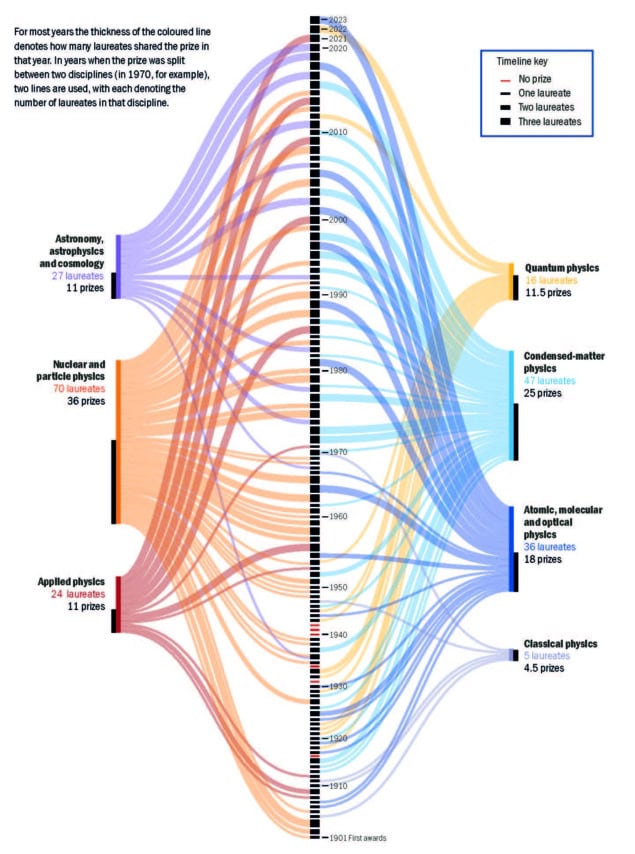
Part of the fun of the run-up to the announcement of the Nobel Prize for Physics is the speculation – serious, silly or otherwise – of who will be this year’s winner(s). Here at Physics World, we don’t shy away from making predictions but our track record is not particularly good.
That’s not surprising, because the process of choosing Nobel winners is highly secretive and we know nothing about who has been nominated for this year’s prize. That’s thanks to the 50 year embargo on all information related to the decision.
The 2024 prize will be announced tomorrow and if you would like to know more about how the Nobel Committee for Physics operates, check out this article that’s based on an interview with a former committee chair: “Inside the Nobels: Lars Brink reveals how the world’s top physics prize is awarded”.
Charting history
Several years ago we created an infographic that charts the history of the Nobel Prize for Physics in terms of the discipline of the winning work (see figure). For example, last year the prize was shared by Pierre Agostini, Ferenc Krausz and Anne L’Huillier for their pioneering work using attosecond laser pulses to study the behaviour of electrons. We categorized this prize as “atomic, molecular and optical” and you can see that prize at the top of the infographic, connected to its category by a darkish blue line.
As well as revealing which disciplines of physics have received the most attention from successive Nobel committees, the infographic also shows that some disciplines fall in and out of favour, while others have produced a steady stream of winners over the past 12 decades. The infographic shows, for example, the return of quantum physics to the Nobel realm. The discipline was popular with the Nobel committee in the 1910–50s and then fell completely out of favour until 2012.
Another thing that is apparent from the infographic is that after about 1990 there tends to be well-defined gaps between disciplines. And for no good scientific reason, we have decided that we can analyse these gaps and use the results to make predictions!
Partially correct
Last year, we noticed that atomic, molecular and optical physics was due a prize. That observation, it part, led us to predict that Paul Corkum, Ferenc Krausz and Anne L’Huillier would win in 2023. This partially correct prediction has emboldened our faith in the mystical ability of our infographic to help predict winners.
So what does that mean for our predictions for this year?
The infographic makes it clear that we are overdue a prize in condensed matter physics. Some possibilities that we have identified include magic-angle graphene and metamaterials.
So tune into Physics World tomorrow and find out if we are right.

SmarAct proudly supports Physics World‘s Nobel Prize coverage, advancing breakthroughs in science and technology through high-precision positioning, metrology and automation. Discover how SmarAct shapes the future of innovation at smaract.com.
The post Use our infographic to predict this year’s Nobel prize winners appeared first on Physics World.

